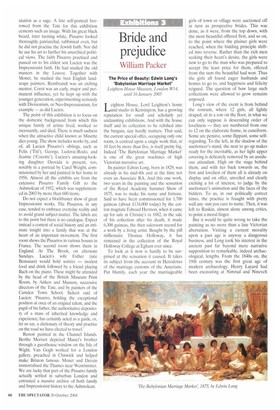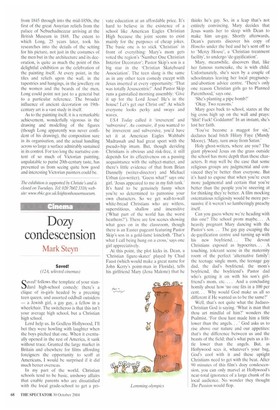Bride and prejudice
William Packer
The Price of Beauty: Edwin Long's 'Babylonian Marriage Market' Le gluon House Museum, London W14, until 16 January 2005
Leighton House, Lord Leighton's home and studio in Kensington, has a growing reputation for small and scholarly yet undaunting exhibitions. And with the house itself and its collection to be relished into the bargain, size hardly matters. That said, the current special offer, occupying only one room, is centred upon a single work that, at 10 feet by more than five, is itself pretty big. Indeed 'The Babylonian Marriage Market' is one of the great machines of high Victorian narrative art.
Its painter Edwin Long, born in 1829, was already in his mid-10s and at the time not even an Associate RA. And this one work, two years in the painting and the sensation of the Royal Academy Summer Show of 1875, was to make his name and fortune. Said to have been commissioned for 1,700 guineas (about £134,000 today) by the cotton magnate Edward Hermon, when it came up for sale at Christie's in 1882, in the sale of his collection after his death, it made 6,300 guineas, the then saleroom record for a work by a living artist. Bought by the pill millionaire Thomas Holloway, it has remained in the collection of the Royal Holloway College at Egham ever since.
To look at it now is hardly to be surprised at the sensation it caused. It takes its subject from the account in Herodotus of the marriage customs of the Assyrians. Put bluntly, each year the marriageable girls of town or village were auctioned off in turn as prospective brides. This was done, as it were, from the top down, with the most beautiful offered first, and so on, to the point where the plainer girls were reached, when the bidding principle shifted into reverse. Rather than the rich men seeking their heart's desire, the girls were now to go to the man who was prepared to accept the least price for them, offered from the sum the beautiful had won. Thus the girls all found eager husbands and homes to go to, and happiness and felicity reigned. The question of how large such collections were allowed to grow remains unposed.
Long's view of the event is from behind the rostrum, where 12 girls, all lightly draped, sit in a row on the floor, in what we can only suppose is descending order of loveliness — they are numbered from one to 12 on the elaborate frame, in cuneiform. Some are pensive, some flippant, some selfregarding. To the left, in the shadow of the auctioneer's stand, the next to go up makes ready for the inevitable, as her light upper covering is delicately removed by an assiduous attendant. High on the stage behind them, and with her back towards us, the first and loveliest of them all is already on display and on offer, unveiled and clearly exciting a lot of interest, to judge by the auctioneer's animation and the faces of the bidders. To us, in our politically correct times, the practice is fraught with pretty well any -ism you care to name. Then, it was left to Ruskin, almost alone among critics, to point a moral finger.
But it would be quite wrong to take the painting as no more than a late Victorian aberration. Visiting a current morality upon a past age is anyway a dangerous business, and Long took his interest in the ancient past far beyond mere narrative supposition to remarkable, indeed archaeological, lengths. From the 1840s on, the 19th century was the first great age of modern archaeology. Henry Layard had been excavating at Nimrud and Nineveh from 1845 through into the mid-1850s, the first of the great Assyrian reliefs from the palace of Nebuchadnezzar arriving at the British Museum in 1848. The extent to which Long, 25 years later, took his researches into the details of the setting for his picture, not just in the costumes of the men but in the architecture and its decoration, is quite as much the point of this delightful exhibition as the celebration of the painting itself. At every point, in the tiles and reliefs upon the wall, in the tapestries and hangings, in the jewellery on the women and the beards of the men, Long could point not just to a general but to a particular reference. The broader influence of ancient decoration on 19thcentury art is a vast study in itself.
As to the painting itself, it is a remarkable achievement, wonderfully vigorous in the drawing and modelling of the figures (though Long apparently was never confident of his drawing), the composition sure in its organisation, and the actual handling across so large a surface admirably sustained in its control. For too long the narrative content of so much of Victorian painting, unpalatable to purist 20th-century taste, has prevented us from seeing quite how good and interesting Victorian painters could be.
The exhibition is supported by Christie's and is closed on Tuesdays. Tel: 020 7602 3316; webwww.rbkc.gmukIleightonhousemuseum.



















































































































 Previous page
Previous page